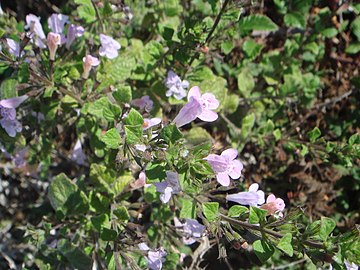
Oregano is a species of flowering plant in the mint family Lamiaceae. It was native to the Mediterranean region, but widely naturalised elsewhere in the temperate Northern Hemisphere.

Spearmint, scientific name Mentha spicata, also known as garden mint, common mint, lamb mint and mackerel mint, is native to Europe and southern temperate Asia, extending from Ireland in the west to southern China in the east. It is naturalized in many other temperate parts of the world, including northern and southern Africa, North America, and South America. It is used as a flavouring in food and herbal teas. The aromatic oil, called oil of spearmint, is also used as a flavoring and sometimes as a scent.
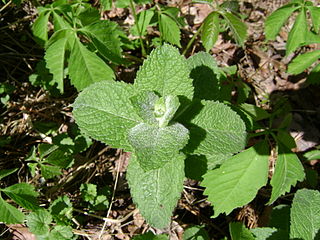
Mentha suaveolens, the apple mint, pineapple mint, woolly mint or round-leafed mint, is a member of the mint family Lamiaceae. It is native to southern and western Europe including the Mediterranean region. It is a herbaceous, upright perennial plant that is most commonly grown as a culinary herb or for ground cover.

Primula vulgaris, the common primrose, is a species of flowering plant in the family Primulaceae, native to Eurasia. The common name is primrose, or occasionally common primrose or English primrose to distinguish it from other Primula species referred to as primroses.
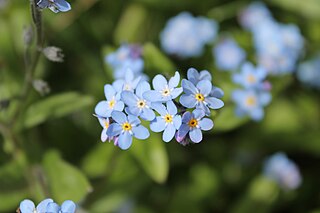
Myosotis sylvatica, the wood forget-me-not or woodland forget-me-not, is a species of flowering plant in the family Boraginaceae, native to Europe. This spring-flowering plant and its cultivars, typically with blue flowers, are the familiar forget-me-nots of gardens.

Banksia meisneri, commonly known as Meisner's banksia, is a shrub that is endemic to a small area in the south-west of Western Australia. It has crowded, more or less linear leaves and in winter and spring, spikes of golden brown flowers followed by furry fruit which usually only open after fire.

Clinopodium grandiflorum, the large-flowered calamint, showy calamint or mint savory, is a species of ornamental plant.
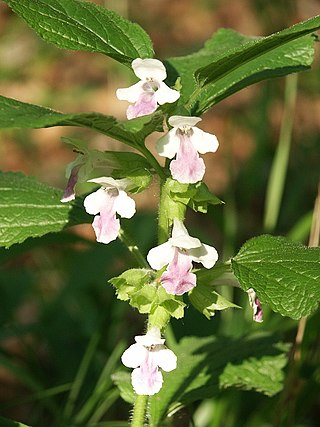
Melittis melissophyllum is a species of flowering plant in the mint family, Lamiaceae. Its common name is bastard balm. It is the only species in the monotypic genus Melittis. The genus name is derived from the Greek melitta, which is in turn from melissa.
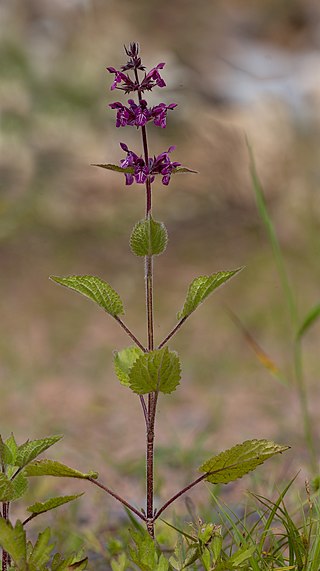
Stachys sylvatica, commonly known as hedge woundwort, whitespot, or sometimes as hedge nettle, is a perennial herbaceous plant growing to 80 cm (31 in) tall in woodland and unmanaged grassland. In temperate zones of the northern hemisphere it flowers in July and August. The flowers are purple. The leaves, when crushed or bruised, give off an unpleasant fetid smell.
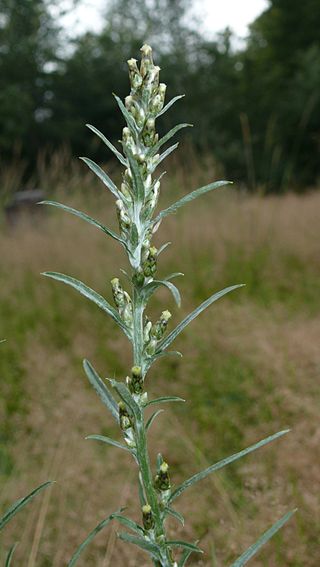
Omalotheca sylvatica, synonyms including Gnaphalium sylvaticum, is a species of plant in the family Asteraceae. It is commonly known as heath cudweed, wood cudweed, golden motherwort, chafeweed, owl's crown, and woodland arctic cudweed. It is widespread across the temperate Northern Hemisphere, throughout North America and Eurasia. The species was first formally described by Carl Linnaeus in 1753 as Gnaphalium sylvaticum.

Clinopodium nepeta, known as lesser calamint, is a perennial herb of the mint family.
Monardella undulata subsp. crispa, synonym Monardella crispa is a rare subspecies of flowering plant in the mint family known by the common name crisp monardella. It is endemic to California, where it is known only from the sand dunes on the coastline of San Luis Obispo and Santa Barbara Counties.

Clinopodium mimuloides is a species of flowering plant in the mint family known by the common name monkeyflower savory. It is endemic to California.
"Wild basil" is a common name for several plants in the mint family (Lamiaceae):

Prostanthera cryptandroides is a species of flowering plant in the family Lamiaceae and is endemic to eastern Australia. It is a low, spreading shrub with narrow egg-shaped leaves and lilac to mauve flowers arranged singly in leaf axils.
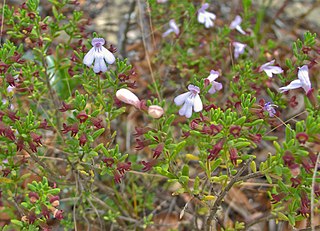
Clinopodium ashei is a species of flowering plant in the mint family known by the common names Ashe's savory and Ashe's calamint. It is native to Florida and Georgia in the United States.

Clinopodium dentatum is a species of flowering plant in the mint family known by the common names toothed savory and Florida calamint. It is native to Florida and Georgia in the United States.
Nepeta italica subsp. troodi, synonym Nepeta troodi, commonly known as Troodos cat-mint is a suberect, aromatic, perennial herb, 20–50 cm high, with a woody base and hairy tetragonal shoots. The leaves are opposite, simple, serrate, cordate at the base, deltoid, with an obtuse apex, 1-4 x 0.6–2 cm, petiolate, densely hairy. The flowers are arranged in many flowered verticillasters, and are zygomorphic, with a white corolla white and a dotted purple lower lip. It flowers June to October. The fruit is composed of 4 nutlets.

Clinopodium coccineum, commonly known as scarlet calamint or red basil, is a evergreen perennial plant of the family Lamiaceae.

